Travelling, exploring or vacationing often pushes you outside your comfort zone. It can inspire you, give you new perspectives, and allow you to learn about different ways of living.
It’s a chance to gain new experiences, grow as an individual, and find your true self. And to discover more about yourself, you need peace. And while vacationing, a temple is a place where you experience peace.
If you are holidaying in Bali, it is an absolute blessing to visit Bali temples. Plan your Bali itinerary, but don’t forget to add the best temples of Bali to your list, as Bali is an incredible destination filled with spiritual retreats.
Bali has many sacred sites, like the famous Tanah Lot, which sits on a rock by the sea, and the impressive Besakih Temple. These places show Bali’s spiritual heart. To enjoy your visit, it’s important to know the best time to go to Bali.
|
Do You Know about Water Temples in Bali? It is believed that the water temples of Bali serve a crucial function beyond their spiritual significance; they are responsible for managing the irrigation system that supports the rice fields in the villages surrounding each temple. Consequently, these temples hold a prominent position as revered worship sites among the farming community. |
As you plan your trip, discovering the best places to stay in Bali is key to a memorable experience. The island offers a variety of accommodations, from the luxurious best resorts in Bali with private pools for ultimate relaxation to cosy villas that give you a sense of local living.
With so many incredible attractions, Bali is home to more than 45 places to visit in Bali, that includes temples too. Tourists, especially Indians, love Bali temples. Do you know why?
|
Balinese mythology shares many similarities with Hindu mythology due to the profound influence of Hinduism on the island of Bali, which began around the 1st century AD. In Bali, the local belief system is a unique blend of Hinduism and indigenous animistic beliefs. This fusion is reflected in mythology, where Gods, deities, and stories from Hindu mythology are integrated with local spirits and ancestral worship. |
Tanah Lot Temple
Tanah Lot Temple is among the best temples in Bali with the most beautiful view. It is a place where you can talk to nature, seek blessings in the temple and feel peace.
The name “Tanah Lot,” which translates to “Land in the Sea” in Balinese, truly reflects its lovely seaside location. About an hour and a half from Ubud, this sacred site provides a peaceful spiritual experience. You will see astonishing views where nature and architecture come together beautifully.

You will be mesmerised to see the incredible location of this Bali temple. Located on a rugged cliff in Tabanan, Bali, the iconic Tanah Lot temple stands majestically against the backdrop of a vast, open ocean.
As the sun begins to set, the sky transforms into a breathtaking palette of vibrant oranges, deep purples, and soft pinks, casting a warm glow over the temple and the crashing waves below.
This Balinese temple is known for its surprising coastal rock formations. These rocks have been shaped over many years by the powerful ocean waves. Each wave crashes against the rocks, creating a beautiful sight as it sends sprays of seawater into the air. The waves leave behind smooth, shiny surfaces that reflect the sunlight.
The temple itself is an ancient Hindu shrine believed to have been constructed in the 16th century. It has intricate carvings and ornate details that tell the stories of Balinese mythology and spirituality.
The air is filled with the calming sound of the waves, creating a serene ambience that invites contemplation and reverence. This enchanting site not only serves as a place of worship but also as a reminder of the powerful connection between nature and spirituality that is deeply woven into the fabric of Balinese culture.
|
History of Pura Tanah Lot Temple: The history of this site goes back to the 16th century and involves Dang Hyang Nirartha, a well-respected religious leader in Bali. He built a system of three temples in Balinese villages: Bale Agung Temple, Puseh Temple, and Dalem Temple. While travelling to the southern coast of Bali, he spent the night on a small rock island called Gili Beo, which looks like a bird. There, he felt enlightened and inspired to build a shrine. However, the village leader was unhappy about this and expelled Nirartha from Gili Beo. According to Balinese mythology, Nirartha used his divine powers to move the rock into the sea, where he built a temple and named it Tanah Lot. |
- Location: Beraban, Kediri, Tabanan Regency, Bali 82121, Indonesia
- Timings: 7 AM- 7 PM
Uluwatu Temple
Uluwatu Temple is one of the six key temples known as Pura Sad Kahyangan, which are considered Bali’s spiritual pillars. Uluwatu offers lovely sunset views similar to Tanah Lot Temple.
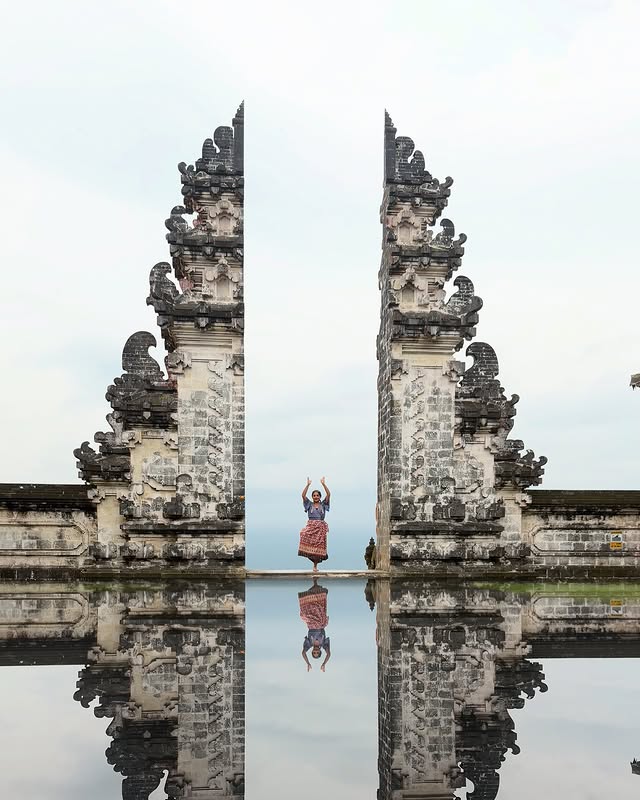
The Balinese Hindus believe that the powers of the Hindu Trinity: Brahma, Vishnu, and Shiva, merge at Uluwatu Temple. This belief makes the temple a significant place of worship for Shiva Rudra, the Balinese Hindu deity who embodies all elements and aspects of life in the universe.
What truly sets Uluwatu Temple apart is its breathtaking location perched high on a steep cliff, where it commands a spectacular view of the rolling waves crashing against the rugged shores of the Indian Ocean.
The name “Uluwatu” derives from the Balinese words, with “Ulu” meaning ‘top’ or ‘tip’ and “watu” translating to ‘stone’ or ‘rock,’ perfectly encapsulating its majestic setting. This ancient temple has a rich history and is thought to date back to the 10th century. Archaeological remains found in the area support this belief.
Visitors can access Uluwatu Temple through two distinct entrances: one that greets them from the south and another that invites exploration from the north, each offering its own unique perspective of this iconic spiritual site.
The most Popular Kecak Dance:
In the enchanting evening hours, just at the temple’s entrance, a captivating spectacle unfolds:
the Kecak Dance, a traditional Balinese performance. This mesmerising display features a circle of men dressed in striking black and white sarongs seated in a lotus position on the ground.
As the sun sets, they begin to raise their hands in unison, chanting the rhythmic and hypnotic “ke-cak-ke-cak,” which echoes through the air. The atmosphere is electrifying, as the dancers embody the spirit of ancient tales, bringing to life vibrant stories from Balinese mythology.
The intricate interplay of sound, movement, and the backdrop of the temple creates an unforgettable experience that immerses the audience in the rich cultural heritage of Bali.
|
Stories about the origin of Uluwatu Temple: Uluwatu Temple was started by Mpu Kuturan, a monk from the Majapahit kingdom. He founded other important temples in Bali as well. Another story says that Dhang Hyang Dwijendra, also known as Danghyang Nirartha, designed the Uluwatu Temple and other temples in Bali, Lombok, and Sumbawa. Until 1983, Pura Uluwatu was difficult to reach. In 1999, lightning struck and damaged parts of the temple. Since then, there have been several restoration efforts. |
- Location: Pecatu, South Kuta, Badung Regency, Bali, Indonesia
- Timings: 7 AM- 7 PM
Ulun Danu Beratan Temple
Ulun Danu Beratan Temple is one of the must-see water temples in Bali dedicated to the Goddess Danu, who is revered as the goddess of water, lakes, and rivers. The temple is situated on the shores of Lake Bratan in the mountains near Bedugul, approximately a one-hour drive from Ubud.

The reflective surface of Lake Beratan makes the temple appear as if it is floating. The nearby mountains create a hazy and dreamy background. This beautiful scenery and the cool air make the temple a popular spot for visitors.
The floating temple complex has four groups of shrines, including the well-known Lingga Petak shrine on the east side. Each group has a gate facing one of the four cardinal directions. The second group is located in the west and honours another temple on Puncak Mangu Hill, which symbolises fertility. Mangu Hill is northeast of Lake Beratan.
As you walk through the temple gates, you’ll see traditional Balinese architecture, including tiered shrines. Inside the complex, the three main shrines are dedicated to the god Vishnu, which has 11 tiers; god Brahma, with 7 tiers; and Shiva, which has 3 tiers.
The temple complex is positioned on low land near the lake. You can see the floating effect best when the lake’s water levels rise. This is the ideal time for taking great photos. Also, the large flower-filled gardens by the lake provide many great photo opportunities and a lovely experience.
- Location: Danau Beratan, Candikuning, Baturiti, Tabanan Regency, Bali 82191, Indonesia
- Timings: 7 AM- 7 PM
Tirta Empul Temple
Tirta Empul Temple is a sacred water temple in Bali, renowned for its beautiful holy springs. The name “Tirta Empul” translates to “holy water spring” and refers to a specific water source located within the temple.
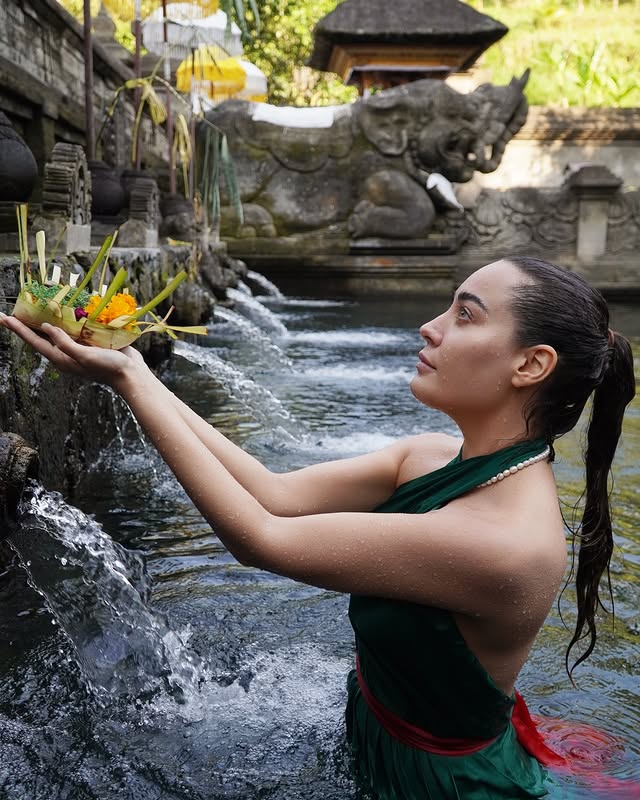
The spring features several purification baths, pools, and fish ponds that surround the outer perimeter, all flowing into the Tukad Pakerisan River.
|
Origin of this Temple: According to legend, Lord Indra created a holy spring known as “The Amerta” to save his troops by providing an antidote to a venomous spring created by the evil king Beelzebub Mayadenawa. Many believe that the construction of this traditional architecture is tied to the legendary epic battle between the powerful and magical king Mayadenawa and the God Indra. |
It is believed that this spring has healing properties. Along its edge, there are purification baths featuring a total of 13 elaborately sculpted spouts that run from west to east. The water from the last two of these spouts is reserved solely for purification during funerary rites.
After offering solemn prayers at an altar-like shrine, individuals enter the crystal-clear, cold mountain water. With their hands pressed together, they bow beneath the gushing water of the first spout and continue to the 11th.
The temple complex features a petirtaan, or bathing structure. Tirta Empul is believed to be a source of clean water for ritual bathing, known as holy water with curative properties.
This tradition continues largely unchanged, attracting tourists from around the world who come to admire the site’s beauty and experience the refreshing, blessed water for themselves.
- Location: Tampaksiring, Gianyar Regency, Bali 80552, Indonesia
- Timings: 8 AM-6 PM
- Entry Fee: 400 INR
Goa Gajah
Goa Gajah, also known as the Elephant Cave, stands as one of the oldest and most distinctive historical sites in Bali. Situated in the village of Bedulu, it is just a 13-minute drive from the centre of Ubud.

This remarkable temple, constructed in the 9th century, functioned as a sanctuary and a sacred site dedicated to prayer and meditation. Despite its evocative name, the Elephant Cave does not actually house any elephants within its shrines.
The cave derives its name from a remarkable stone statue of the Hindu God Ganesh, who is depicted with the head of an elephant. This statue can be found prominently displayed inside the temple, serving as a focal point for visitors and worshippers alike.
|
Importance of this Temple: In addition to the Ganesh statue, the cave complex features fragmentary remains of a lingam, a symbol representing the Hindu god Shiva, known for its phallic form. This structure is complemented by its female counterpart, the yoni, which symbolises divine feminine energy. Together, they embody the principles of creation and fertility in Hindu philosophy. |
Furthermore, the complex is adorned with seven statues of women, each holding a water pitcher. These statues represent the seven holy rivers of India, which hold significant spiritual importance in Hindu tradition.
The presence of these elements makes the Elephant Cave a rich site of cultural and religious significance, attracting visitors who wish to explore its artistic and spiritual heritage.
- Location: Bedulu, Blahbatuh, Gianyar Regency, Bali, Indonesia
- Timings: 8 AM-6 PM
- Entry Fee: 270 INR
Taman Ayun Temple
Taman Ayun translates to “beautiful garden.” It is a must-see Bali temple and a notable landmark in the village of Mengwi.
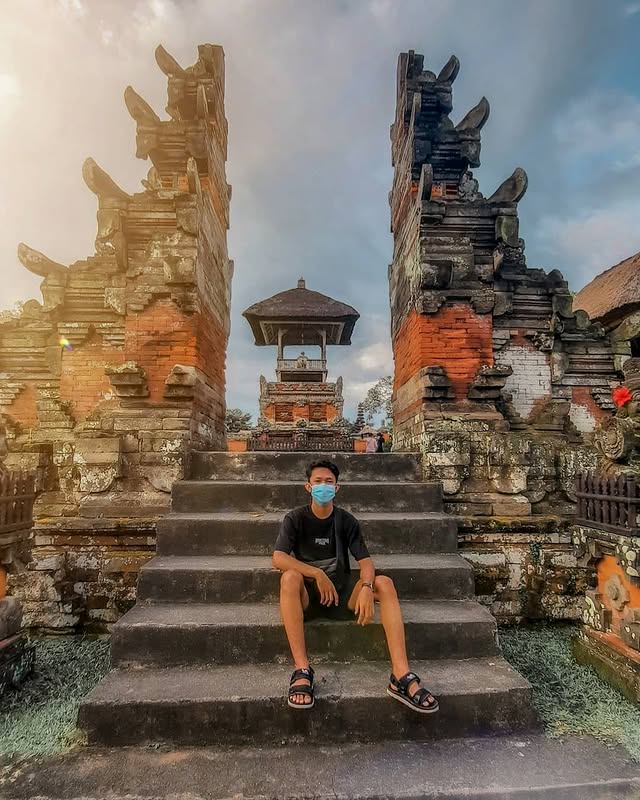
This exquisite temple is celebrated for its exquisite traditional architecture, characterised by intricately designed structures that reflect the rich cultural heritage of Bali.
|
History of the Temple: Pura Taman Ayun is a temple built during the Mengwi era. In 1634, King I Gusti Agung Putu of Mengwi constructed this temple to honour his ancestors. The temple is known for its tall tiers, which represent the Mengwi people’s respect for their noble figures. It is called the ‘mother temple’ of Mengwi. The Taman Ayun Temple serves as the main site for worship among the Mengwi people, allowing them to avoid long trips to larger temples. |
The temple is surrounded by large gardens where visitors can walk through the green spaces. In these gardens, calm fish ponds filled with lotus flowers shine in the sunlight, creating a peaceful atmosphere.
Taman Ayun is not just a temple; it’s a picturesque spot that captivates the senses and offers a glimpse into the island’s spiritual and artistic legacy.
- Location: Jl. Ayodya No.10, Mengwi, Kec. Mengwi, Kabupaten Badung, Bali 80351, Indonesia
- Timings: 8 AM- 6:15 PM
Lempuyang Temple
Lempuyang, also called Pura Lempuyang Luhur, is the oldest and highest temple in Bali. It stands at 1,175 meters above sea level. Upon arriving at the temple, you are greeted by the enchanting view of Mount Agung framed by the famous “Gates of Heaven.”
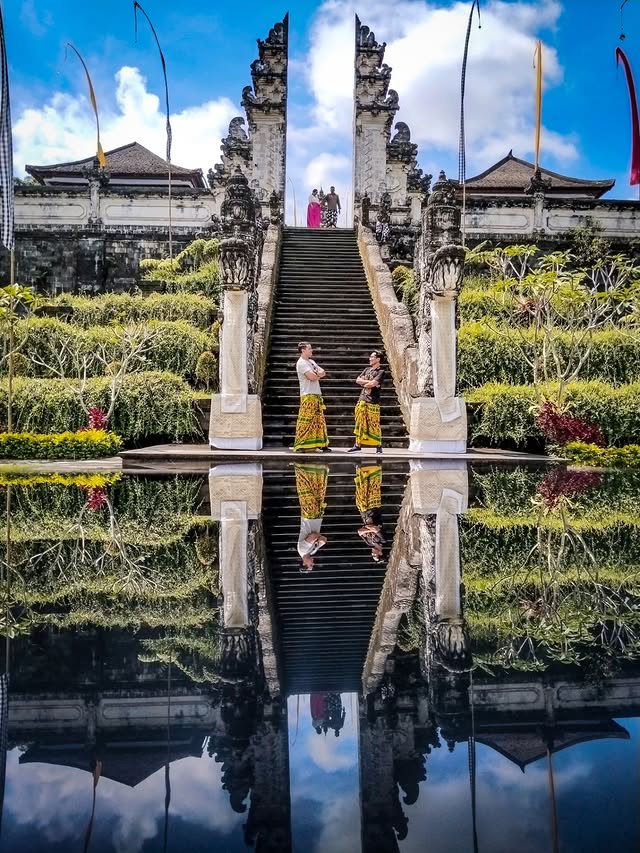
Visitors can choose to enjoy the beautiful views of Lempuyang Temple at the mountain’s base or climb over 1,700 steps to reach the top. The climb is both energising and rewarding, with each step revealing more stunning sights.
As you go higher, you will see the green forested hills below, creating a beautiful natural scene. At the top, you will also see Mount Agung, which is Bali’s highest peak.
This mountain is not only impressive but also holds spiritual importance as it is home to Besakih Temple, known as Bali’s Mother Temple. The mix of physical effort and amazing scenery makes this experience unforgettable.
- Location: Tri Buana, Abang, Karangasem Regency, Bali, Indonesia
- Timings: 8 AM-6 PM
Pura Besakih
Besakih Temple is commonly known as Bali’s “mother temple.” It is a magnificent complex that consists of at least 86 clan temples and shrines. Located on the southwestern slopes of Mount Agung, it stands at an elevation of 1,000 meters above sea level.
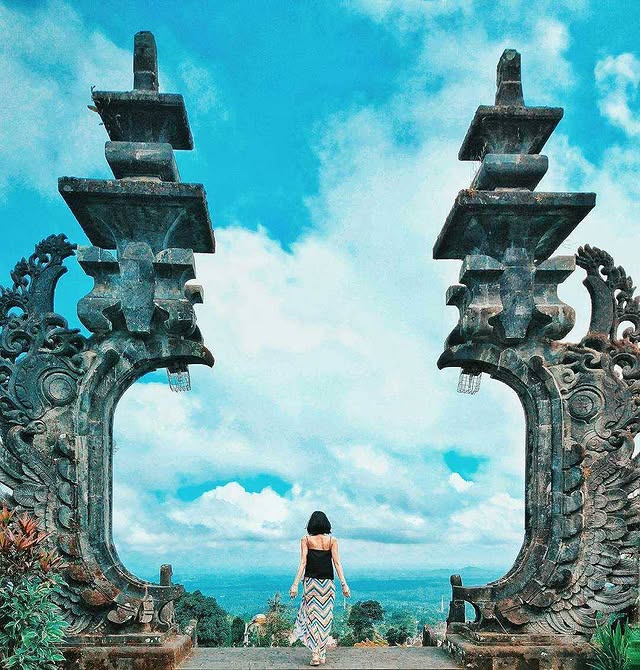
Every year, at least 70 celebrations happen at Besakih because each shrine has its own anniversary. Besakih is the largest and holiest temple in Bali.
It is located high up, offering beautiful views of the countryside, including rice paddies, hills, mountains, and streams. You can spend a whole day exploring the site. Pura Besakih is special because it welcomes all visitors, no matter their caste.
|
History of Pura Besakih Temple, Bali: In the 8th century, a Hindu monk named Gangga Ra from India had deep insights while in seclusion. These experiences inspired him to build shelters for his community. However, the construction faced many challenges, and several of his followers sadly got sick or had accidents during this hard work. Once the shelters were finished, the place was named ‘Basuki.’ This name honours the dragon deity ‘Naga Besukian,’ who is believed to live on the sacred slopes of Mount Agung. The name ‘Basuki’ has an important cultural meaning, showing the deep link between local beliefs and the large volcano. Over time, ‘Basuki’ changed to ‘Besakih,’ making the area known as the Mother Temple of Bali. |
Pura Besakih has become a key place for pilgrims looking for spiritual peace. This spiritual site features three distinct shrines representing the Trinity of the Hindu religion-
- Pura Penataran Agung: Located at the centre of the Besakih Temple, this shrine is dedicated to Lord Shiva, the destroyer, and is adorned with white banners.
- Pura Kiduling Kreteg: To the right of Pura Penataran Agung, this sanctum, marked by red banners, is dedicated to Lord Brahma, the creator.
- Pura Batu Madeg: This temple, which is dedicated to Lord Vishnu, the protector, is characterised by its black banners.
- Location: Besakih, Rendang, Karangasem Regency, Bali 80863, Indonesia
- Timings: 8 AM-6 PM
Pura Taman Kemuda Saraswati
Pura Taman Saraswati, also known as Taman Saraswati Temple, is a very popular water temple famous for its beautiful lotus flowers. This temple features classic Balinese architecture and has a lovely entrance with peaceful ponds.
Frangipani trees line the edge of the pond, adding charm to the temple. A bridge connects the temple’s outer area to the main gate. Visitors can cross over impressive statues that line the edges. As you approach the main gate, you will see three large doors decorated with golden ornaments.
The construction of the Pura Saraswati Temple, also known as the Ubud Water Palace Temple, began and was completed in 1952. The name Pura Saraswati is intended for the worship of Dewi Saraswati, the Hindu goddess of knowledge and science.
The architect of Pura Taman Saraswati Ubud was Mr. I Gusti Nyoman Lempad, who is a renowned sculptor and architect in Bali. This temple was commissioned by Prince Ubud Cokorda Gede Agung Sukawati.
- Location: F7V6+JHX, Jl. Kajeng, Ubud, Kecamatan Ubud, Kabupaten Gianyar, Bali 80571, Indonesia
- Timings: 8 AM-6 PM
Pura Dalem Agung
Pura Dalem Agung Padangtegal is a Hindu temple found in the southwestern area of the Sacred Monkey Forest complex. It is often called the Temple of Death and is dedicated to the Hindu God Shiva, known as Hyang Widhi.
This temple features decorations of Balinese demonic women with bulging eyes, long tongues, sharp fangs, and sagging breasts, creating a spooky atmosphere. In Balinese stories, these demons are associated with the underworld, known as ‘bhur,’ which is part of why the temple is named Pura Dalem Agung Padangtegal.
Pura Dalem Agung Padangtegal features a spacious open courtyard that is mainly used for traditional Kecak fire and trance dance performances. Additionally, there is a music pavilion known as the gamelans, which houses an ensemble of instruments resembling xylophones. These instruments are crafted from wood and bronze, with intricate carvings of mythical creatures from Balinese mythology.
The ground of the temple complex has a striped pattern composed of alternating bands of grass and stone. This design is thought to symbolise the balance between the two dichotomies of good and evil, a concept that is significant in Balinese religion.
Additionally, the temple hosts the Kecak Fire Dance, often referred to as the classical “monkey chant” dance. Performances are held every Wednesday and Saturday at 7:30 PM in the courtyard of the temple complex.
- Location: Jl. Monkey Forest, Ubud, Kecamatan Ubud, Kabupaten Gianyar, Bali 80571, Indonesia
- Timings: 8 AM-6 PM
Things to Remember Before Visiting Bali Temples
Each temple possesses its own unique cultural identity, and it is imperative that tourists adhere to the established rules and regulations while demonstrating respect for local traditions. In order to uphold the sanctity of the temples in Bali, there are several key guidelines that must be observed.
Wear a Sarong and Shash
When visiting Bali temples, it is also essential to dress modestly. Both men and women are required to wear sarongs that cover their legs below the knee when visiting Hindu and Buddhist temples.
A sarong is typically included in the ticket price at most temples, if not, then rent one, it doesn’t cost much. Also, don’t forget to cover your back and shoulders.
Rules for Women
Women who are menstruating at the time of their visit are not allowed to enter the temple. This practice is based on traditional beliefs that associate menstruation with a state of impurity and concerns regarding the presence of unsanctified blood within sacred spaces.
Most locals respect personal privacy, but some may ask about your menstrual status. Women who are more than seven months pregnant or who have given birth in the last six weeks should not enter the temple.
Respect the Rules and the Areas of Worship
It is important to uphold a respectful approach when visiting spiritual monuments and places of worship. For instance, it is prohibited to sit on or climb upon structures such as walls or statues for the purpose of taking photographs.
Additionally, visitors are advised to refrain from taking pictures in areas where such activity is explicitly prohibited. It is essential to honour the sanctity of worship areas and temple sanctums.
Conclusion
Bali stands out as an ideal travel destination for Indians, with a rich cultural heritage, incredible natural beauty, and an incredibly welcoming atmosphere. For people seeking spiritual solace, Bali’s must-see temples, such as Uluwatu Temple, Tanah Lot and many more, offer an incredible experience with their unique architecture and serene surroundings.
While exploring the island’s cultural side, visitors can also indulge in the best waterfalls in Bali, like Tegenungan and Gitgit, which provide a perfect contrast to the temples’ serenity, adding a touch of nature’s wonder to the journey.
After seeking blessings from Bali temples, then comes the time to have some vegetarian food at any of the Indian restaurants in Bali. This combination of sacred sites, natural beauty, and familiar cuisines makes Bali an attractive choice for Indians looking for an exotic yet culturally resonant vacation.
But don’t forget to explore the local markets near temples, where you can pick up the best things to buy in Bali, ranging from intricate handicrafts to beautiful textiles. With these tips, your Bali getaway will be not only a chance to visit its famous temples but also a journey to relax, discover, and enjoy the island’s best offerings.
Frequently Asked Questions about Bali Temples
What are the famous temples in Bali?
Some of the famous temples in Bali include Tanah Lot, Uluwatu Temple, Besakih Temple, Tirta Empul, and Pura Ulun Danu Bratan. These temples are not only historically significant but also offer stunning views and unique cultural experiences.
Which are the best temples in Bali to visit?
The best temples in Bali to visit are Besakih Temple, known as the “Mother Temple,” Tanah Lot for its seaside beauty, and Tirta Empul for its sacred spring. These temples offer spiritual experiences along with breathtaking surroundings.
What is the significance of the water temple in Bali?
Water temples in Bali, such as Tirta Empul, are sacred places where Balinese Hindus perform purification rituals. The water is believed to have holy, healing properties, and these temples are often linked to Bali’s ancient irrigation system, symbolising the connection between the spiritual and natural world.
What can I expect from Bali’s temples?
Bali, Indonesia temples are deeply connected to the island’s Hindu culture and spirituality. Visitors can expect intricate architecture, serene settings, and opportunities to witness traditional ceremonies and rituals. Many temples, like Tanah Lot and Uluwatu, also offer stunning views, adding to the spiritual experience.
Which Bali temples should I visit?
Bali temples to visit include Uluwatu Temple for its cliffside views, Besakih Temple for its grandeur, and Tirta Empul for its sacred water rituals. Don’t miss Pura Ulun Danu Bratan, which sits beautifully on the shores of Lake Bratan, and the tranquil Pura Taman Ayun.
Is there a floating temple in Bali?
Yes! Pura Ulun Danu Bratan, often called the floating temple Bali, is located on Lake Bratan in the mountains. The temple appears to float on the water, creating a magical reflection and a peaceful atmosphere, making it one of Bali’s most photographed sites.
Is there an underwater temple in Bali?
While Bali does not have an official underwater temple, there is an intriguing underwater temple in Bali in Pemuteran. This site is part of a conservation project aimed at preserving marine life, where visitors can see submerged statues and sculptures while diving.
What are some must-see temples in Bali?
Some Bali must-see temples include Tanah Lot for its iconic sea view, Uluwatu Temple for its clifftop setting and cultural performances, and Besakih Temple for its historical and spiritual importance. These temples offer both visual and cultural enrichment during your Bali visit.